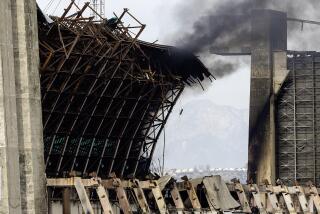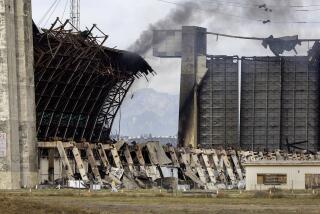A FINE MESS, INDEED : Dining at the Tustin Marine air station was judged the best in the corps. High marks were given for its ambiance and service, and the prices are reasonable, too
- Share via
It’s official: The Tustin Marine Corps Air Station now has a certificate to prove it has bragging rights as the best Marine chow hall in the world.
This week, Mess Hall 184 officially received the secretary of the Navy’s Maj. Gen. W.P.T. Hill Award, recognizing it as the best in the corps. The mess, which feeds about 1,500 people a day, won over 10 other entrants ranging from Iwakuini air station in Japan to Parris Island, S.C.
So how can one particular chow hall be the best? A team of Food Services top brass made the selection, not a panel of restaurant critics. And a lot of the things they looked for are of little gastronomic interest, apart from speed of service and cleanliness, where Mess Hall 184 happened to score very well. They were things like good paper work, maintenance, administration and budgeting.
Unlike a restaurant, which can invest in costlier ingredients and expect to make back the expense in volume, a military mess has to follow a strict budget that works out to about $1 a meal.
No secret chef’s recipes are allowed, either. Everything must come out of a box of military recipe cards arranged in a 42-day repeating cycle of menus. And a mess hall can’t hire any chef it wants. It has to take its cooks as they come from the Cooks and Bakers Training School in Camp Lejeune, N.C.
Credit is given, of course, for doing a good job on the recipes. “Cooks have a tendency to cut corners,” said Master Gunnery Sgt. Mitchell M. Mills, the officer in charge of the mess. “A good chief cook can watch for that.”
But an important factor is what Mills calls “doing a little more for the troops.” This is an area where the Tustin mess has a definite edge. Mess Hall 184 more or less pioneered the “bars” that are far from common in military dining: the cold-cut sandwich bar, the ice cream dessert bar and the potato bar. Another uncommon touch for mess halls is the decoration on the chow line counter top. It might be carved vegetables one day and rainbow patterns of colored shredded coconut another.
An important criterion is that all this has been done within budget. There’s strict security around all the refrigerators to prevent pilferage, but a far trickier job is calculating the number of meals the hall will have to serve. Tustin’s base population goes up and down, depending on whether there is a helicopter transport ship in port. And the week before payday, Marines are more likely to eat on base. By shrewd figuring, Mills’ crew has been guessing the number of meals to prepare within 2%.
Another criterion is “command interest,” that is, interest on the part of the base command. Mills has gotten enthusiastic support from his commanding officer on his various innovations, and the Officers’ Wives Club even gave the mess an eight-unit gas barbecue for outdoor dining. And on certain nights, officers replace the civilian employees dishing out food in the chow line.
It also seems that the cooks--all Marines and all trained at Camp Lejeune--have learned fancy icing on their own for their military-recipe pastries.
The cooks also have cooking contests among themselves and invite people from the community. Here they make elaborate food presentations not at all from the military recipe collection: things like shrimp trees and ice carving. All the expense of the cooking contests comes from the cooks’ own pockets.
About once a month, the galley crew donates its labor to local charity functions like Tustin’s Neighbor Relief. They’ve also entered chili contests in Tustin; in fact, they won with a standard military recipe.
In the future, Mess Hall 184 will be even less like the usual chow hall. A $152,000 remodeling will turn one side of the hall into a McDonald’s-style fast-food place and the other into a fancier, more restaurant-like hall with soft booths.
More to Read
Eat your way across L.A.
Get our weekly Tasting Notes newsletter for reviews, news and more.
You may occasionally receive promotional content from the Los Angeles Times.







